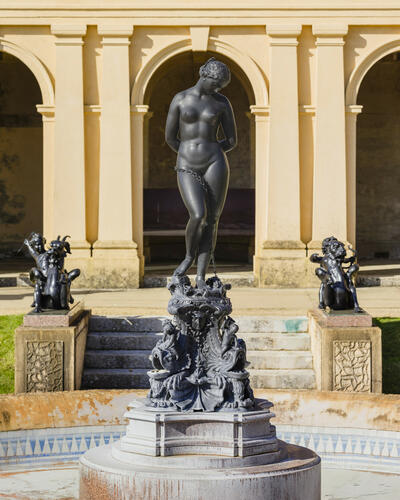-
1 of 253523 objects
-
A bronze fountain group of Andromeda, her hands tied behind her back, nude and standing on a four-cornered plinth cast with Medusa masks, putti riding sea monsters and scallop shells, on pink granite four cornered and cylindrical base. As told by the Latin poet Ovid, Andromeda was the daughter of an Ethiopian King who had been chained to a rock as a sacrifice to a sea-monster but was saved by the audacious Perseus. The narrative of Andromeda’s ill-fated destiny and the intervention of Perseus is cleverly told through the symbols and attributes that the artist has included in this composition. Whilst Andromeda is shown full length still chained up to the rock and in a grief-stricken contraposto pose, the rocky feature on which Andromeda stands reveals her happier ending. It has been suggested that the influence of the Italian Mannerist sculptor Benvenuto Cellini is evident in the design of the decorative elements that form the base. The Medusa head medallion – an attribute of Perseus and a feared symbol of his bravery - and the figures of the putti or Cupids slaying the sea-monsters are a reference to the heroic rescue of Andromeda by Perseus. The group was made by the English sculptor John Bell and it was cast by the Coalbrook Dale Company. The statue was shown in the 1851 Great Exhibition where it was noticed by Queen Victoria who acquired it for the gardens of Osborne House, her summer residence in the Isle of Wight. It became the first in a series of royal commissions. Like some other subjects made by Bell this bronze statue was reproduced in Parian porcelain (a more affordable version of china pocelain) by W. T. Copeland and by Henry Cole's Art Manufactures.
Provenance
Purchased by Queen Victoria at 1851 Great Exhibition for the gardens at Osborne House
-
Creator(s)
(sculptor)(founder (metals))Acquirer(s)
-
Medium and techniques
Cast bronze



